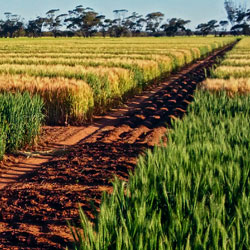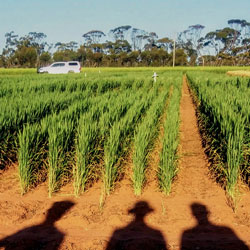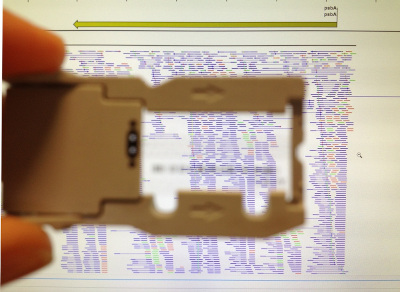PROGRAM 1
Energy metabolism and signaling
PROGRAM 2
Gatekeeper cells and specialisation
PROGRAM 3
Gene variants and epigenetics
 Tools for Hybrid Crop Breeding
Tools for Hybrid Crop Breeding
The use of hybrid crop varieties is increasing because of their attractive agronomic traits. Development of hybrid breeding systems requires a means to control self-pollination. Cytoplasmic male sterility (CMS) and fertility restoration is one approach that has been exploited, but the lack of suitable restorer genes has been a major limiting factor.
Work by the Centre has identified PPRs as the major group of restorer of fertility (Rf) genes in plants and we are developing approaches to find effective natural variants and to design synthetic ones. By identifying Rf genes in genomic data from cereals (including wheat, rye, barley and sorghum) the Centre is helping its partners to use this approach to restore male fertility. Our partners, including Limagrain, University of Queensland and the U.S. Department of Agriculture, will test candidates in field trials.
We believe this approach will be valuable to plant breeding companies keen to develop new hybrid varieties, particularly in crops where such hybrids have been difficult to create.
 Genomic Approaches For Phosphate Use Efficiency
Improvement
Genomic Approaches For Phosphate Use Efficiency
Improvement
Phosphate remains a major cost as a fertiliser and significantly limits plant growth in harsh nutrient-limited environments. We still require fundamental knowledge of how plants gain and retain phosphate in order to make them more efficient users of this limiting resource.
Three “genomic” approaches are being undertaken by the Centre to make discoveries to alter the phosphate relations of plants. Firstly, cell-specific regulators of phosphate uptake and use in plants is being investigated. Secondly, we are screening Arabidopsis accessions for differences in responses to phosphate limiting conditions using Genome Wide Association Studies (GWAS). Thirdly we are using SPX4-Luc in a forward genetic screen to identify regulators of phosphate sensing.
These projects are aimed to identify novel genes for Phosphate Use Efficiency in plants that can be transferred to our academic or commercial partners for evaluation and study under field conditions.
 Relevant Modelling of Climate
Relevant Modelling of Climate
The Centre is working at the frontline of plant research that utilises systems to model dynamic climatic conditions in physiologically and ecologically relevant ways. The research team has developed pipelines that enable high throughput studies under dynamic environmental conditions using growth chamber technology.
Spectral climate chamber facilities enable the fine control of light intensity and spectrum, temperature and moisture to simulate local and regional field-like conditions from particular locations and seasons. Refining the use of such systems equips the Centre with the means to perform future work in climate analogues that mimic specific growing regions with climate change scenarios, greatly enhancing translation of the Centre’s discoveries to real-world application. These systems are being developed by the Centre not only for important small plants such as Arabidopsis and Brachypodium, but also for crop plants, such as wheat and foundation species such as Eucalyptus.
In 2019 we completed the 'Grain Phenomics Climate Facility', with four larger grow capsule climate containers that have two rooms each. This new facility has extra high, multi coloured light and energy efficiency, in order to grow populations of plants under simulated field conditions.
 Growing More for Less – Energy Use Efficiency for Wheat
Yield
Growing More for Less – Energy Use Efficiency for Wheat
Yield
To address the need for dramatic global crop yield increases in order to meet future food security needs, the Agriculture Ministers of the G20 nations established the International Wheat Yield Partnership (IWYP) - a unique, multi-national funding initiative to co-ordinate wheat research efforts globally.
The PEB-led IWYP project Improving Wheat Yield By Optimising Energy Use Efficiency is using teams at UWA, UA and ANU to examine the relationship between photosynthesis, respiration, growth and yield in order to exploit the energy systems of wheat plants and dramatically increase their productivity. Along with partners at the ARC Centre of Excellence in Translational Photosynthesis and the International Maize and Wheat Improvement Centre (CIMMYT) the team is using hyperspectral measurements of photosynthesis, high-throughput measures of respiration, biochemistry and genetics, along with field-based physiological measurements in a novel approach to screen wheat populations and identify new yield-related traits.
Since the project’s commencement, glasshouse trials in the Adelaide Plant Accelerator and five field trials in Mexico and Canberra have been completed, over fifteen-hundred cultivars screened, over two-fold differences in respiration rates identified and proteomic and metabolomic analysis of many hundreds of samples conducted. The information is being applied to produce new models of energy efficiency and novel markers and hyperspectral measures that can be deployed in breeding programs to enhance wheat yield potential.
 Building Salt Tolerant Crops
Building Salt Tolerant Crops
Many commercial crops are sensitive to soil salinity, causing major yield losses every year. The Centre has led a number of studies aimed at increasing salinity tolerance in crop plants important to the Australian economy including wheat, barley, and grapevine, and the internationally significant legume, soybean.
GmSALT3 was identified by Centre researchers as a gene conferring salt tolerance to soybean plants and this information can now be used in breeding programs to ensure that tolerance is maintained in future cultivars of soybean that will be grown in areas prone to soil salinity. Furthermore, the novel way in which this gene was found to confer salt tolerance is driving the search for similar genes in different crops to explore if it contributes to their salt tolerance. New insights on the wheat HKT protein – uncovered in one of the foundation studies of the Centre as responsible for excluding toxic sodium ions from the shoot – has shown how the structure of this protein results in its effectiveness to transport sodium and confer salt tolerance in multiple crops including grapevine, wheat and barley.
 Methods and Data underlying (epi)Genomics of Climate
Adaptation
Methods and Data underlying (epi)Genomics of Climate
Adaptation
In 2019, PEB released several studies that advance knowledge of the underlying basis of plant adaptation to climate. Utilising new genomic and phenomic tools developed by the Centre, as well as high powered mapping populations, valuable methods and data underlying the (epi)genomics of climate migration and adaptation in plant model and foundation species was achieved.
HOME (Histogram Of MEthylation), a new method for the accurate identification of differentially methylated regions of plant and other genomes was described. Further, new studies using the model organisms Arabidopsis and Brachypodium revealed the genetic basis of adaptation to photo-protection under high light and seasonal conditions.
Understanding of the genetic basis of complex, adaptive traits facilitates better modelling, prediction, and selection in crops and foundation species. Our research has generated key assets for future work by the broader community towards the adaptation of plants under future climates.
